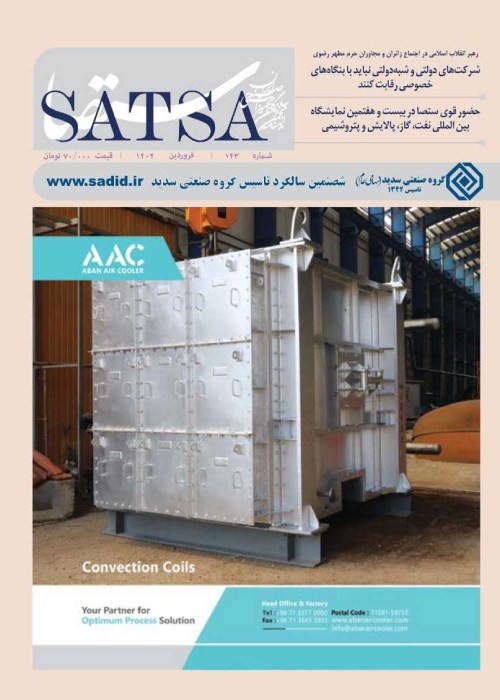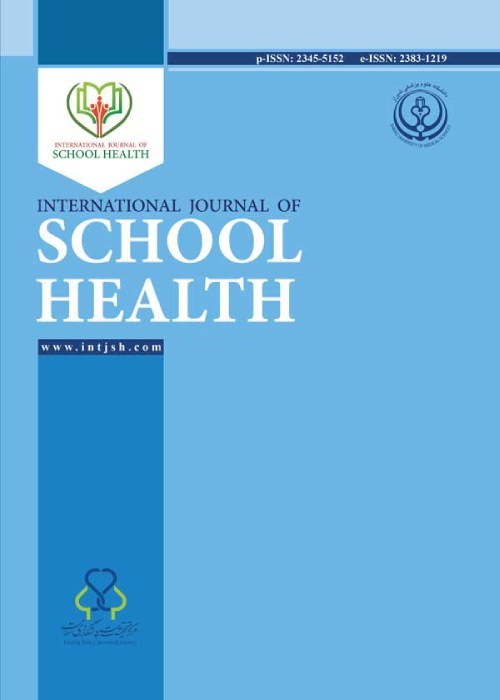فهرست مطالب

International Journal of School Health
Volume:10 Issue: 2, Spring 2023
- تاریخ انتشار: 1402/02/25
- تعداد عناوین: 8
-
-
Pages 53-61BackgroundPhysical fitness in Cameroonian students has been assessed previously, but most have focused on urban areas. This study aimed to objectively evaluate two components of physical fitness and factors associated with it among urban and semiurban secondary school students in two municipalities in the Littoral province, Cameroon.MethodsA cross-sectional study was conducted between January and April 2021 in three randomly selected secondary schools in the Littoral Province. The study included 459 students aged 10 to 15 years, comprising 252 students from urban areas (UA) and 207 from semi-urban areas (SUA). Each student’s height, weight, and blood pressure were assessed, and two field tests (20-m shuttle test and 4x10-m test) were performed to estimate maximal oxygen uptake (VO2max) and measure agility. Descriptive and inferential statistics were used for data analysis.ResultsThe overall prevalence of overweight/obesity was 21.4%, with a higher prevalence of overweight/obesity among boys in semi-urban areas and an equal prevalence of overweight among urban and semi-urban girls. SUA students performed significantly better in the speed test (4x10-m) and VO2max (P<0.001 and P=0.01, respectively) compared to UA students. A comparison of age groups [ (10-12 yrs) and (13-15 yrs)] showed no significant difference in VO2max values between urban and semi-urban dwellers (P=0.06 and P=0.29, respectively). VO2max values were above the threshold values associated with the risk of developing cardiovascular diseases.ConclusionsUrban students were less physically active than semi-urban students, but the prevalence of overweight/obesity was similar in both settings.Keywords: Physical fitness, Schoolchildren, Urban, Rural, Cameroon
-
Pages 62-68Background
Repetitive negative thinking, including rumination, is associated with a variety of depressive symptoms in students. This study aimed to investigate the effect of positive self-talk training on depression alleviation in students with suicidal ideation.
MethodsIn this quasi-experimental research, we employed a pretest-posttest control group design. The statistical population consisted of all depressed students with suicidal ideation in Heris County (East Azerbaijan Province, Iran) during the 2021–22 academic year. Purposive sampling was used to select 34 students as the research sample. They were then randomly assigned into an experimental group and a control group (17 participants per group). Both groups took a pretest, and the Beck Depression Inventory was used to collect the necessary data. The experimental group received positive self-talk training in eight 90-minute sessions (two sessions a week), after which both groups took the posttest. ANCOVA was used for data analysis in SPSS version 26.
ResultsThe study included 34 male and female students with an average age of 15.12±2.69 years. The mean±SD of depression in the experimental group in the pretest and posttest stages were 37.53±6.62 and 12.47±6.33, respectively (P<0.001). The difference between the mean±SD of depression in the control group was not significant in the pretest (33.65±6.59) and posttest (37.12±6.30) stages. The results showed that positive self-talk training had a significant effect on depression in students with suicidal ideation (P<0.001). Thus, positive self-talk training alleviated depression in the students.
ConclusionPositive self-talk training can be applied to mitigate depression in students with suicidal ideation. The findings of this study can be practically beneficial to psychologists, school counselors, principals, and teachers.
Keywords: Optimism, depression, Suicidal ideation, Students, Positive psychology -
Pages 69-81BackgroundLiving in marginalized areas with challenging socio-economic contexts can make teenagers vulnerable. This study aimed to investigate high-risk behaviors and their determinants amongst teenage students living in marginalized areas of Southwest Iran.MethodsThis was a cross-sectional study with mixed-method desgin, in which 421 students completed a questionnaire in September 2018, and seven focused group discussions were conducted from October 2018 to January 2019 in a marginalized district of Shiraz, Southwest of Iran. Descriptive statistics were used to describe the data, and multiple logistic regression was used for statistical analysis. Quantitative data were analyzed using STATA14 (Stata Corporation, College Station, TX, USA) software, and qualitative data analysis was done using comparative content analysis. The risk behaviors examined in this study were tobacco, alcohol, sexual relations, and substance use.ResultsIn total, 34.7% of the participants were engaged in at least one of the high-risk behaviors. Based on multiple logistic regression analysis, parents’ marital status (ORDivorced&Dead/Living together=3.50, P=0.016), fathers’job (ORUnemployment/Employment=6.61, P=0.004), family history for addiction (ORYes/No=2.62, P=0.001), and friendship with the opposite sex (ORYes/No=2.56, P<0.001) were among the observed risk factors for high-risk behaviors. Qualitative results indicated that family-related conflicts, personal characteristics, and environmental challenges are predisposing determinants for involving in high-risk behaviors among teenagers.ConclusionHigh-risk behaviors are mostly prevalent among adolescents living in marginalized areas. To combat and mitigate the consequences of these behaviors, policymakers must focus on reducing social injustice, improving teenagers’ resiliency and family solidarity, and creating a safe environment.Keywords: Adolescent, Sexual behavior, Alcohol drinking, Drug use, Slums
-
Pages 82-91BackgroundToday, the country’s education system, especially in high school, is facing the challenge of academic failure and lack of academic motivation among students. This study aimed to compare the effectiveness of mindfulness training and internetbased acceptance and commitment training on academic engagement, mental time travel, and students’ anxiety during the COVID-19 pandemic.MethodsThis study was semi-experimental designed by pre-test and post-test with a control group and a follow-up period. The statistical population consisted of all the female senior high school ((including 3 years from the ninth to the twelfth grade). in districts 1 and 2 of Sari city, Mazandaran province, Iran in the academic year 2021-2022. The research sample consisted of 45 female students (15 female students from the first experimental group, 15 female students from the second experimental group, and 15 female students from the control group) from among all the female senior high school in districts 1 and 2 of Sari city in the academic year 2020-2021, and they were selected by a random multi-stage sampling method. To collect data, Schaufeli et al.’s (2002) academic engagement questionnaires, Eren’s mental time travel scale (2009), and Beck anxiety inventory (1999) were used. For the experimental groups, mindfulness training and internet-based acceptance and commitment training were implemented during eight sessions, and during this period, the subjects of the control group did not receive any intervention. The data of the research were analyzed using the analysis of variance test with repeated measurements in SPSS version 26 and a significance level of 0.05.ResultsBased on the demographic findings, the mean±SD age in the acceptance and commitment group was 15.98±3.17, in the ACT group it was 16.11±3.24, and in the control group it was 16.36±3.49. The results of analysis of variance with repeated measurement showed that mindfulness training and internet-based acceptance and commitment training have a significant effect on students’ academic engagement, mental time travel, and anxiety (P<0.001). Also, the effectiveness of education based on acceptance and commitment on academic engagement was higher than mindfulness education (P<0.001). However, the effectiveness of mindfulness training on mental time travel and anxiety was higher than training based on acceptance and commitment (P<0.001).ConclusionBased on the results of the analysis, it can be concluded that internet-based mindfulness training and acceptance and commitment therapy can be considered in academic engagement, mental time travel, and anxiety of students.Keywords: Mindfulness, Acceptance, commitment, Academic engagement, Mental time travel, Anxiety, COVID-19
-
Pages 92-97Background
Considering the burden of moderate and severe brain injury on families and society, and that trauma is one of the common causes of death and disability in Iran, this study aimed to investigate the frequency of death from severe to moderate brain injury in children with brain trauma.
MethodsIn this cross-sectional study, records of 126 patients under 18 years of age with moderate and severe brain injuries admitted to Namazi Hospital, Shiraz, Iran during 2017-2019 were investigated. The relative frequency of mortality, parents’ education level, day of trauma, types of trauma, age, gender, and length of hospitalization were studied. P values were set at 0.05; Chi-square and T-test were used for variable comparisons.
ResultsThe study’s male-to-female ratio was almost 2:1, and the mean and standard deviation of the age of all children in the study was 6.84±4.33. The relationship between brain injury severity and hospitalization length was significant (P<0.001). 21.4% of patients with moderate and severe brain injury were Afghan. The highest frequency of trauma was related to accidents, with 69.8%, followed by falling down at 23.8%.
ConclusionThe most common cause of death in children with brain injury was trauma caused by an accident. To decrease the burden of severe and moderate brain injury in children, health policymakers may tailor interventions to two important groups, including parents with a low level of education and Afghan nationals.
Keywords: Child Injuries, Brain, Death -
Pages 98-105BackgroundAcademic resilience can increase the generalized flexibility of students to confront problems, stresses, and challenging demands and conditions during the school year, leading to success and improvement in academic performance. The present study aimed to investigate the effectiveness of self-regulation training in improving engagement and academic resilience in high school students.MethodsThis research was a quasi-experimental study. The statistical population included all tenth-grade male students in Ahvaz, Iran, in 2021. Forty tenth-grade students were selected through multistage cluster sampling and were randomly placed into intervention and control groups (n=20 students in each group) using a random number table. The intervention group received seven 90-minute self-regulation training sessions, while the control group received no psychological training. The Academic Resilience Scale (ARS) and the Utrecht Work Engagement Scale for Students were administered to both groups (intervention and control) before and after the training sessions. The collected data were analyzed by repeated measures ANOVA in SPSS version 23.ResultsMean (±SD) of academic engagement for the intervention group in the pretest, posttest, and follow-up stages were 46.60±5.83, 54.65±7.96, and 54.55±7.34, respectively; while in the control group, the means were 46.85±6.38, 47.15±5.81, and 47.35±5.98, respectively. Moreover, the mean (±SD) of academic resilience for the intervention group in the pretest, posttest, and follow-up stages were 17.60±3.55, 25.65±4.98, and 25.35±4.22, respectively; while in the control group, the means were 19.80±4.01, 19.35±3.82, and 18.85±4.12, respectively. The results demonstrated a significant difference between the intervention and control groups in the mean scores of student engagement and academic resilience (P<0.001). Accordingly, a significant rise was observed in the intervention group’s posttest scores of student engagement and academic resilience (P<0.001). Moreover, the follow-up showed the stability of the influence of self-regulation training.ConclusionThe study findings indicated that self-regulation training effectively improved student engagement and academic resilience in senior high school male students. Therefore, self-regulation training sessions are recommended to improve the psychological skills of students.Keywords: Emotional regulation, Resilience, Motivation, Students
-
Pages 106-107


